Assessment of the Bill Emerson Memorial Bridge - FTP Directory ...
Assessment of the Bill Emerson Memorial Bridge - FTP Directory ...
Assessment of the Bill Emerson Memorial Bridge - FTP Directory ...
- No tags were found...
Create successful ePaper yourself
Turn your PDF publications into a flip-book with our unique Google optimized e-Paper software.
3. Evaluate <strong>the</strong> model by conducting sensitivity analysis, checking boundaryconditions and compatibility <strong>of</strong> various parts <strong>of</strong> <strong>the</strong> bridge, and making necessaryengineering judgments. Sensitivity analysis will ensure that <strong>the</strong> modeling <strong>of</strong>various parts <strong>of</strong> <strong>the</strong> bridge is consistent in terms <strong>of</strong> member types, geometricaland material properties. Connectivity among various structural members at a jointcould be pretty complicated in a cable-stayed bridge. It needs to be properlymodeled.4. Determine <strong>the</strong> bridge’s dynamic characteristics such as vibration mode shapes andfrequencies. The dynamic characteristics <strong>of</strong> <strong>the</strong> bridge will be identified from <strong>the</strong>measured accelerations due to ambient vibration and <strong>the</strong>y will be compared with<strong>the</strong> calculated values from <strong>the</strong> FE model.5. Verify <strong>the</strong> assumptions used in <strong>the</strong> design <strong>of</strong> <strong>the</strong> bridge structure by understanding<strong>the</strong> structural behavior and load path with <strong>the</strong> well-calibrated FE model when bothground motions and structural responses at critical locations are known.1.5. Significant <strong>of</strong> this studyA number <strong>of</strong> long-span bridges exist near <strong>the</strong> New Madrid Seismic Zone (NMSZ). Many<strong>of</strong> <strong>the</strong>se bridges are subjected to direct threats from <strong>the</strong> NMSZ where <strong>the</strong> largestcontinental earthquake in <strong>the</strong> US history occurred in 1811-1812. Service outage <strong>of</strong> <strong>the</strong>sebridges due to earthquake-induced failure will not only cause traffic congestion in regionbut also sever <strong>the</strong> nation’s ground transportation link along <strong>the</strong> corridor from Californiato New York. The public perception to any <strong>of</strong> <strong>the</strong>se potential incidences is significant.This study helps understand <strong>the</strong> seismic behavior <strong>of</strong> <strong>the</strong> <strong>Bill</strong> <strong>Emerson</strong> <strong>Memorial</strong> Cablestayed<strong>Bridge</strong> under a design earthquake. It identifies key areas and structuralcomponents for inspection <strong>of</strong> <strong>the</strong> bridge after a strong earthquake event in <strong>the</strong> future.The cable-stayed bridge system is unique in several ways, including <strong>the</strong> combined rockand soil conditions, <strong>the</strong> new design feature <strong>of</strong> towers. This study validates some <strong>of</strong> <strong>the</strong>design assumptions by assessing <strong>the</strong> integrity <strong>of</strong> <strong>the</strong> cable-stayed bridge under apostulated design earthquake based on <strong>the</strong> acceleration records during a minorearthquake.This study provides a baseline three-dimensional model <strong>of</strong> <strong>the</strong> cable-stayed bridge thathas been validated with field measurements. This model can fur<strong>the</strong>r be used to developdamage detection and health monitoring schemes <strong>of</strong> <strong>the</strong> bridge to arrive at <strong>the</strong> so calledcondition-based inspection <strong>of</strong> bridge conditions or provide a critical supplement to visualinspection in current practices. The model can also be used to develop and validatecontrol technologies such as those studied by Agrawal et al. (2003) and Dyke et al.(2003).1.6. Organization <strong>of</strong> this reportThis report is divided into seven major sections. Section 1 gives a general introduction on<strong>the</strong> <strong>Bill</strong> <strong>Emerson</strong> <strong>Memorial</strong> Cable-stayed <strong>Bridge</strong>, <strong>the</strong> seismic instrumentation system,scope and significance <strong>of</strong> this study. Section 2 presents a process and methodology toretrieve <strong>the</strong> peak accelerations in a fixed time window from <strong>the</strong> continuous data collectedin real time. In Section 3, some <strong>of</strong> <strong>the</strong> collected data from <strong>the</strong> instrumentation system are7
















